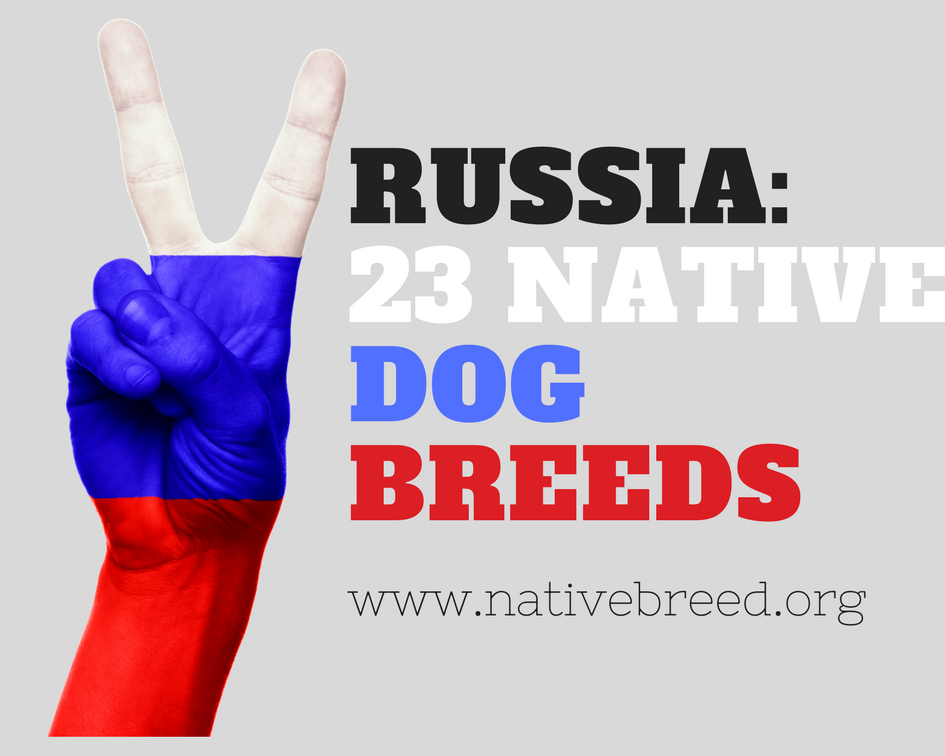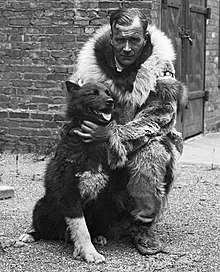1.Black Russian Terrier
The Black Russian Terrier (abbreviated as BRT, Russian: Русский чёрный терьер), also known as the Chornyi Terrier (chornyi being Russian for black) is a breed of dog created in USSR in Red Star (Krasnaya Zvezda) Kennel during the late 1940s and the early 1950s for use as military/working dogs. At the present time, the Black Russian Terrier is a breed recognized by the FCI (FCI’s from September 1983), AKC (AKC’s from July 2004), CKC, KC, ANKC, NZKC and other cynological organizations. The contemporary Black Russian Terrier is a working dog, guarding dog, sporting and companion dog.
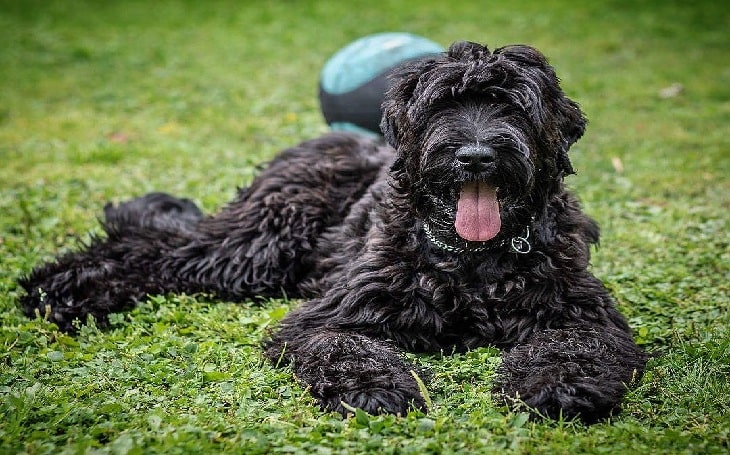
Despite its name, the Black Russian Terrier is not a true terrier: it is believed that about seventeen breeds were used in its development, including the Airedale, the Giant Schnauzer, the Rottweiler, the Newfoundland, the Caucasian Shepherd Dog and other breeds. Read More…
2.Bolonka
The Russian Tsvetnaya Bolonka (Russian: Болонка), also known as the Bolonka Zwetna in Germany, is a rare toy breed of the Bichontype, developed in Moscow and Saint Petersburg, Russia from the ancestors of smaller dogs such as the Bichon Frise, Toy Poodle, Shih Tzu, Pekingese and French Bolognese. They include the white variety, the Franzuskaya Bolonka, which is a variation of the Italian Bolognese. Franzuskaya means French, Zwetna is the German transcription for Tsvetnaya and means “multi-coloured”, and Bolonka translates as “Bolognese” in a number of Slavic languages. The Russian Tsvetnaya Bolonka has recently gained more fame by being the chosen breed of Prince William and Kate Middleton.
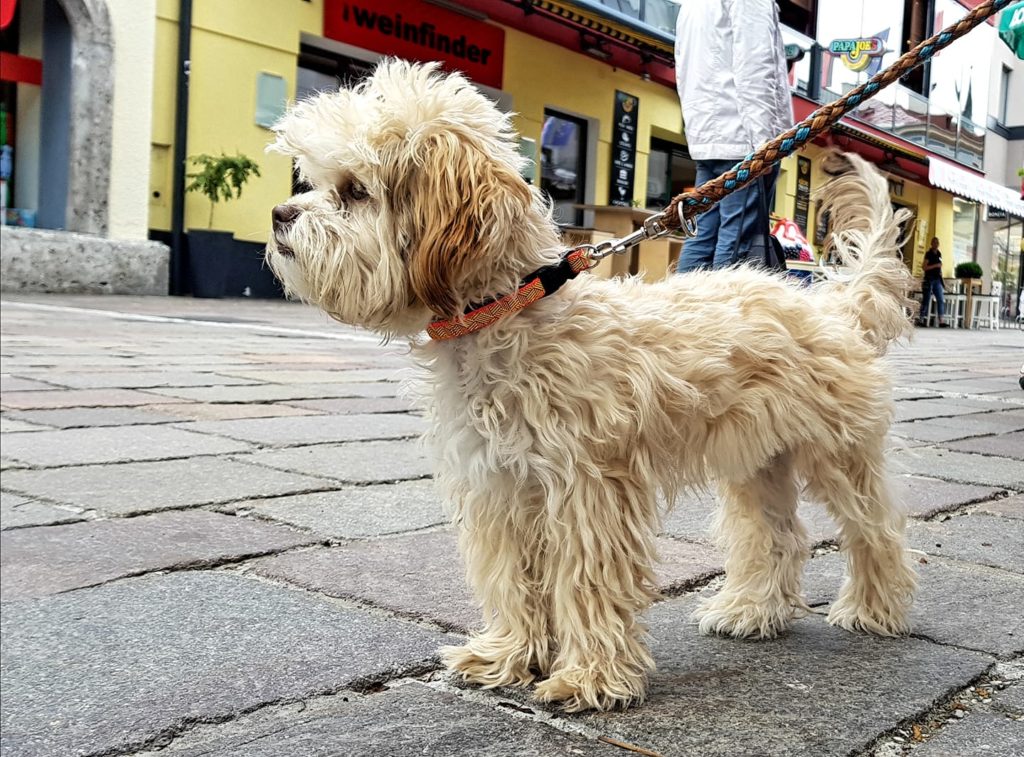
Appearance
Russian Tsvetnaya Bolonki is 18 – 27 cm high at the withers and 2-4 or 5 kg in weight. The Russian Tsvetnaya Bolonka body formation resembles a square, with a long coat that has big wavy curls. The Russian Tsvetnaya Bolonka is moderately boned and should never appear fine-boned. The Franzuskaya Bolonka is white, while the Tsvetnaya Bolonka and Zwetna Bolonka are black, brown, grey, red or wolf-grey. The breed is known for its soft, wavy to curly coat in a variety of colours. They have ears that are neither too long nor too short. Male Russian Tsvetnaya Bolonki has a distinct beard and moustache that sets them apart from their female counterparts. Russian Tsvetnaya Bolonki tails are supposed to have the tip touching the back. Similar to other Bichon breeds, Russian Tsvetnaya Bolonki does not shed. Daily brushing of the coat helps to prevent matting. If a Russian Tsvetnaya Bolonka’s coat gets severely matted, it may develop a hematoma. Russian Tsvetnaya Bolonki is considered suitable for people with allergies, as they are bred to be hypoallergenic. Breeds that do not shed are more likely to be hypoallergenic since the dog’s dander and saliva stick to the hair and are not released into the environment. The frequent trimming, brushing, and bathing required to keep the Russian Tsvetnaya Bolonka looking its best removes hair and dander and controls saliva. It is important to note that how hypoallergenic a particular dog is for a particular person may vary with the individual dog and the individual person.
3.Borzoi
The borzoi (/ˈbɔːrzɔɪ/, literally “fast”), also called the Russian wolfhound (Russian: Ру́сская псовая борзая, romanized: Russkaya psovaya borzaya), is a breed of domestic dog. Descended from dogs brought to Russia from central Asian countries, it is similar in shape to a greyhound and is also a member of the sighthound family.
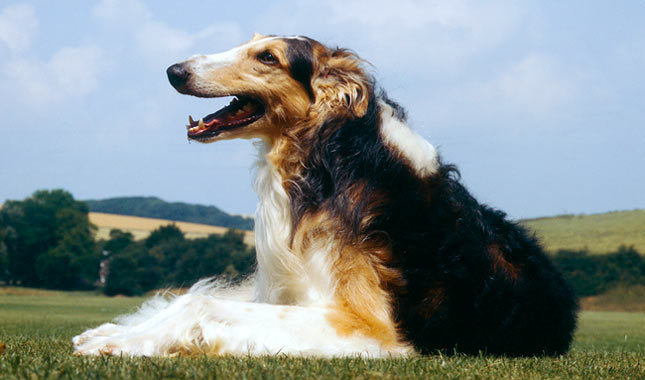
The system by which Russians over the ages named their sighthounds was a series of descriptive terms, not actual names. Borzói is the masculine singular form of an archaic Russian adjective that means “fast”. Borzáya sobáka (“fast dog”) is the basic term used by Russians, though sobáka is usually dropped. The name psovaya derived from the word psovina, which means “wavy, silky coat”, just as hortaya (as in hortaya borzaya) means shorthaired. In modern Russian, the breed commonly called the borzoi is officially known as russkaya psovaya borzaya. Other Russian sighthound breeds are stepnaya borzaya (from the steppe), called stepnoi; and krimskaya borzaya (from the Crimea), called krimskoi.
The most commonly used plural form is the regular formation borzois, which is the only plural cited in most dictionaries. However, the Borzoi Club of America and the Borzoi Club UK both prefer borzoi as the form for both singular and plural forms. Read More…
4.Caucasian Shepherd Dog
The Caucasian Shepherd Dog (Georgian: კავკასიური ნაგაზი; Russian: Кавказская овчарка, romanized: Kavkazskaya ovčarka; Azerbaijani: Qafqaz Çoban iti) is a large guard dog breed from the Caucasus Mountains, commonly bred in the mountainous regions of Georgia.
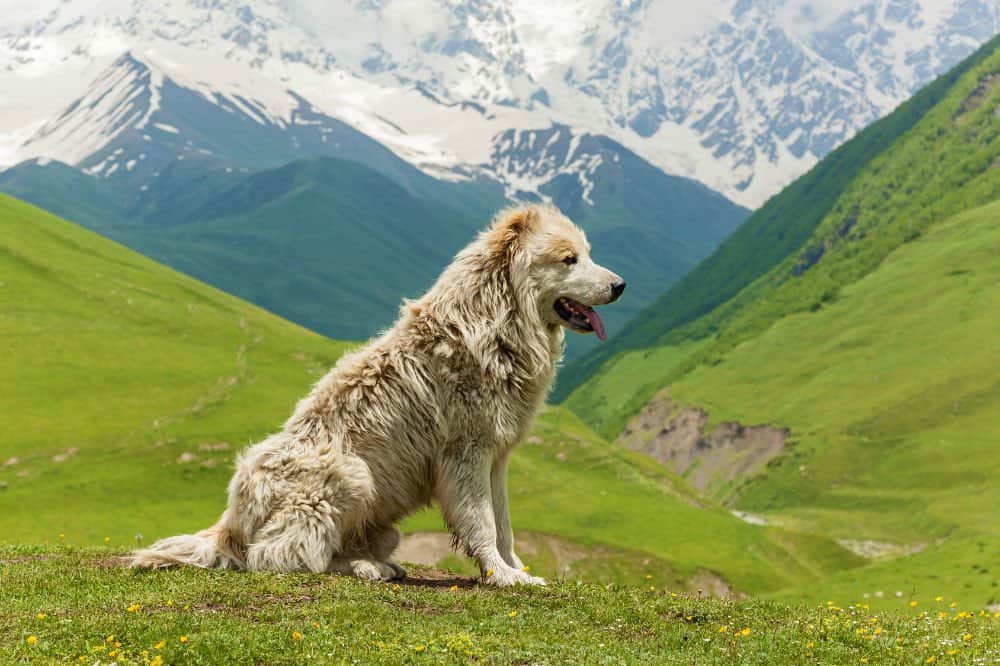
Appearance
The Caucasian Shepherd Dogs are strongly boned, muscular, but handsome and even-tempered molossers. Plain dogs have a shorter coat and appear taller as they are less strongly built. Mountain dog types have a heavier coat and are more muscular.
Caucasian Ovcharka are large dogs. The minimum height for females is 64 centimetres (25 in), with a desirable height between 67 and 70 centimetres (26 and 28 in). The minimum weight for females is 45 kilograms (99 lb). The minimum height for males is 68 centimetres (27 in), with a desirable height between 72 and 75 centimetres (28 and 30 in). The minimum weight for males is 50 kilograms (110 lb)
5.Central Asian Shepherd Dog
The Central Asian Shepherd Dog is an ancient livestock guardian dog breed from the Central Asia region. Traditionally, the breed was used for guarding sheep and goat herds, as well as to protect and for guard duty.
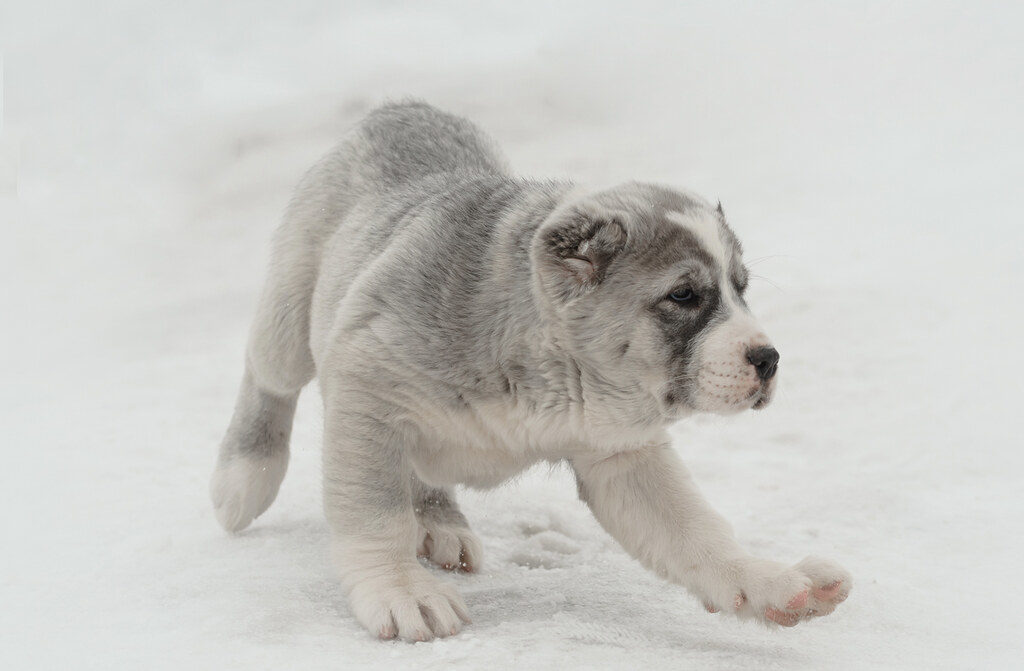
It is a large breed of dog recognized by FCI as a Molossoid type dog breed of Soviet-era origin under Russian patronage. Numerous breed representatives reside in Russia, and local kennel club officials refer to Central Asians as one of the most popular dog breeds in the country, rating them as the number one breed in the country around 2000.
General appearance
This breed presents a robust dog of greater than average size with great strength and power. They are independent, curious and alert, yet imperturbable. The dog is as long as it is tall at the withers or slightly longer than its height. The hair is short or moderately long with a heavy undercoat. Its ears are, in practice, cropped very short, and the tail is docked moderately long (except for dogs from countries where cosmetic surgeries for dogs are illegal). Most common colours are black/white; fawn of different shades, from almost white to deep red; brindle. Some have a black mask.
The head is very solid, without pronounced stop or sculls. The neck is low set, short, with dewlap. The body is fairly broad, proportionate, muscles rather flat. The ribcage appears very long because of developed false ribs. The legs are straight, with heavy boning and moderate yet defined angulation. Leg bones must be in proportion, and shall never give the impression that any bone is short. The rump is broad. The typical gait is a gallop; however, CAO can trot for hours without wearing themselves out.
Read more about: Central Asian Shepherd Dog
6.East Siberian Laika
The East Siberian Laika (Vostotchno-Sibirskaia Laika) is a Russian breed of dog of spitz type, a hunting dog originating in parts of Siberia east of the Yenisei River.
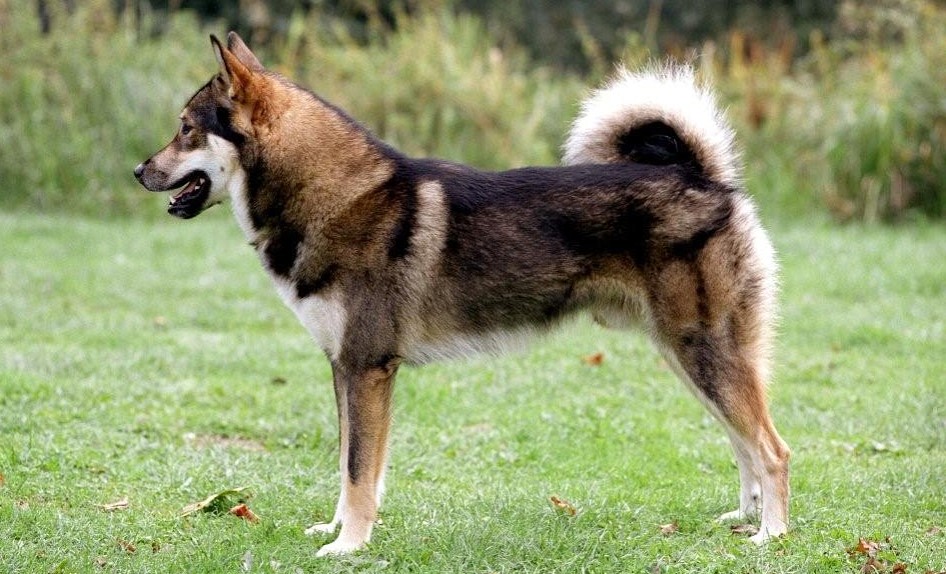
Appearance
Males are 55 to 66 centimetres (22 to 26 in), while females are on the smaller side at 51 to 60 centimetres (20 to 24 in). Black and tan, with light patches (called karamis), grizzle, patched, ticked, white, grey, black, red and brown of all shades. There are two major types, the Evenki and the Irkutsk; other less important types are the Yakutia, Amur and Tofolar. These types vary in colour and physique, as the ESL is still more of a diverse conglomerate breed than the other three Russian Laika breeds. Physically the ESL is somewhat rangy, nearly square in proportion, slightly higher at the withers than at the croup, robust in bone; head shape varies with the regional varieties. Ears are erect and triangular, the tail carried in a curve over the back. The coat is a medium-long double coat with straight coarse guard hair and a soft thick undercoat.
7.East-European Shepherd
The East European Shepherd (VEO) (in Russian: Восточно-европейская овчарка (ВЕО)) is a breed of dog that was developed in the 1930-1950s based on German Shepherds to create a larger, cold-resistant breed for military use, police work and border guard duties in the Soviet Union. VEOs are also used as guide dogs for the blind and as therapy dogs. This breed is popular in Russia, where it entered a public culture and acquired a legendary status as an extremely smart and loyal dog devoted to its owners. The breed is well-known in other ex-Soviet Union republics. In the West, the East-European Shepherd is a rare breed that is not well known. Information about the breed on online sources in English is limited and often incorrect or distorted.
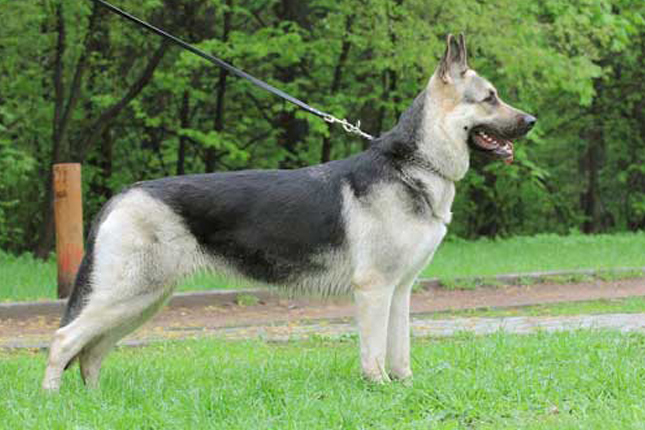
Appearance
The East European Shepherd is larger than a German Shepherd. Males are 66-76 centimetres (26–30 inches) at the withers and weigh 35–60 kg (75-130 lbs), females are 62-72 centimetres (24.5–28 inches) and weigh 30–50 kg (66-110 lbs). Along with a short coat of dense fur, they have strong (but not coarse) bones and well-developed muscles. Their coat is medium in length with a well-developed undercoat. The standard colours for these dogs include well-defined sable grey, sable red and addled that can be saturated to give an almost black-and-tan or black-and-red appearance with a black face mask and solid black.
The head of an East European Shepherd is of a ‘wolfish’ appearance resting on a long neck in a rather massive collar fur and is proportional to the rest of the body. It is triangular and wedge-shaped with a slightly rounded forehead. The muzzle is equal in length to the skull and the lower jaw is well-developed. With large teeth in full complex and powerful jaw muscles, the dog is capable of a very strong hold and scissor-cutting bite. Their ears are medium in size and pricked. Their eyes are medium, oval and dark with close-fitting, well-coloured eyelids.
Their backs are straight, strong, wide and long. They are 10-17% longer than their height at withers. The loins are long and wide, well-muscled and slightly arched. Their croup is wide, long and slightly sloping towards the tail. The tail is long, bears thick fur, erected in a form of a sword when the dog is excited. The chest is moderately wide, while the belly is reasonably tucked up. The chests are scimitar in form, reaching the hocks or slightly longer in some cases. The legs are strong and straight and feet are oval and compact. The dog’s pace is of a trotter rather than of a skid, sliding just above the ground so typical to other German Shepherds’ cousins.
8.Hortaya borzaya
The Hortaya borzaya (Russian: Хо́ртая Борза́я, IPA: [ˈxortəjə bɐrˈzajə], Ruthenian and Ukrainian: Xopт, Lithuanian: Kurtas, shorthaired sighthound) is an old Asian sighthound breed originating in the former Kievan Rus, later Grand Duchy of Lithuania (later Polish-Lithuanian Commonwealth) and Russian Empire. It is a dog of large size, of lean but at the same time robust build, of considerably elongated proportions. In its everyday life, the hortaya is quiet and balanced. It has a piercing sight, capable of seeing a moving object at a very far distance. In spite of its calm temperament, the dog has a very active reaction to running game. Hortaya is excellent, enduring hunting dogs endowed with good, basic obedience and completely lacking aggression towards humans.
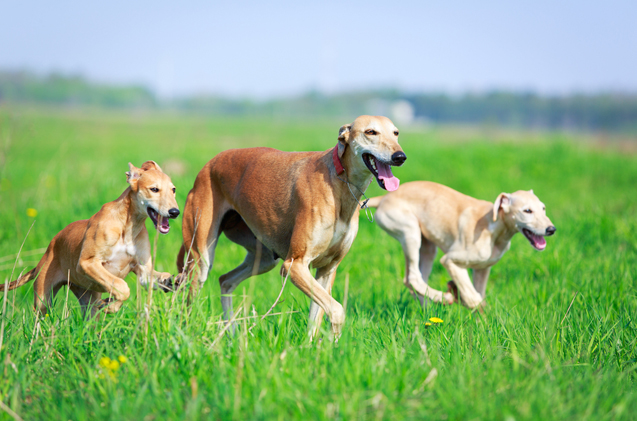
Appearance
The Hortaya is a sighthound of a large to very large size depending on breed type. The breed has five distinct types, with at least as many subtypes to each main type. The result of this is a broad variability, adapting the breed to the large variety of geography, climate and prey found across the huge expanse of its habitat.
All breed standards for Hortaya are performance-based, rather than appearance-based, but because certain characteristics make for skilled hunting dogs, most Hortaya is very similar in shape and build. The legs are long, the spine flexible, and the chest disproportionately deep in comparison to the waist, in order to accommodate large, powerful lungs. Small ears and a long, narrow skull are typical.
Hortaya males range from 26 to 30 inches (65 to 75 cm), females from 24 to 28 inches (61 to 71 cm). The weight depends largely on the type and can range from 18 kilograms (Stavropol-type female) up to 35 kilograms (northern-type male). In general, the Hortaya is heavier than it looks.
When not hunting, the typical gait of the breed is a fluid, limber and effortless trot. When chasing the prey, Hortaya gallops in fast leaps of great length.
The short, dense fur can come in any colour, as the only breed standards for the Hortaya are health and skill. Dark-coloured dogs typically have a black nose, while light-coloured dogs typically have a brown nose. Eyes may be any colour and typically have a black or very dark rim.
Starting in the 2000s, some Hortaya were exported to parts of Europe and North America (see below), where a breed standard for a new, as-yet-unnamed subtype was established. Among these dogs, coat colour and colour combinations are restricted to a few types: white, black, cream of all shades, red, sable and brindle, solid or piebald (with white markings, or white with coloured markings). A black overlay and black mask, grey or red tan markings are normal. Atypical colours and markings, like brown or chocolate, a saddle or dapple pattern, and diluted colours (isabella) with blue or light eyes are not allowed. This subtype is still being defined, and further restrictions may be implemented, but the standard of the original Hortaya remains unchanged.
9.Karelo-Finnish Laika
The Karelo-Finnish Laika is a hunting dog breed from the Karelia area of Russia. It is sometimes referred to as a Finnish Spitz by the Finnish Kennel Club and by the Russian Kennel Federation.
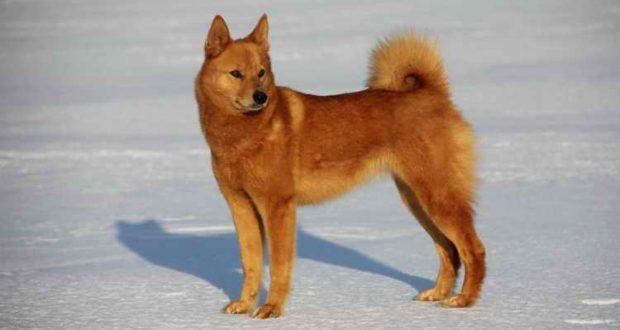
Origin
During the 1930s and 1940s, a government kennel near Medvezhyegorsk raised pure Spitzes. Many of these dogs were lost during World War II and there were only twenty-four of these registered dogs in Petrozavodsk at one time.
The breed was revived in 1953 when Russian cynologists imported three Finnish Spitzes from Finland and bred these three dogs with some of the small red-coated Spitzes that were left in southern Karelia area and in the northern provinces of Russia.
There were also dogs in Leningrad that were very good at hunting that looked a lot like the Finnish Spitzes. These dogs became the Karelo-Finnish Laika. While being a separate breed, the Karelo-Finnish Laika is very similar to its ancestor the Finnish Spitz, which was one of the main reasons people originally registered the breeds as one. Some of the minor differences between the breeds include different variations of the red coat colour, the curving of the tail and the closeness of the bodyguard hair. There were about 200 of these Karelo-Finnish Laikas in Moscow by 1970. They were the smallest of the Laika family and were used for hunting in Russia.
In 2006, the Finnish Kennel Club and Russian Kennel Federation decided to include the Karelo-Finnish Laika within the Finnish Spitz breed. This was due to improve the gene pools of both breeds: for example, the Finnish Spitz often suffered from epilepsy.
However, the Karelo-Finnish Laika (even though not listed in the FCI nomenclature), is still a separate and unique Russian breed, with the first standard published in Leningrad in 1936. It is a close relative of the Finnish Spitz, as both breeds were bred from similar native dog populations.
Appearance
The image to the right is actually a Finnish Spitz, not to be confused with a Karelo-Finnish Laika. The Karelo-Finnish Laika has a double coat. The first layer being a thick undercoat and the second, a straight guard of hairs on top. The colour is allowed to be some variations of red, but pale red is undesirable. There can be white spots on the tip of the tail and on the chest and a white stripe on the forehead. The white spots on the Karelo-Finnish Laika are usually larger than the spots on the Finnish Spitz. Karelo-Finnish Laikas can also have black tips on the hairs that are on their backs. They should be about 38–48 centimetres (15–19 inches) tall and weigh about 11–14 kilograms (24–31 lb). The males have a more square-shaped physique than the females do. This breed has smaller sharp-edged ears, dark round eyes and a black nose. They have deep, flat chests and a tail that is set high.
10.Laika (dog breed)
Laika (Russian: Ла́йка, IPA: [ˈlajkə]) is a type of hunting dog of Northern Russia and Russian Siberia and is a generic name for several breeds. Laika is also the given name for the mongrel who was the first dog in space.
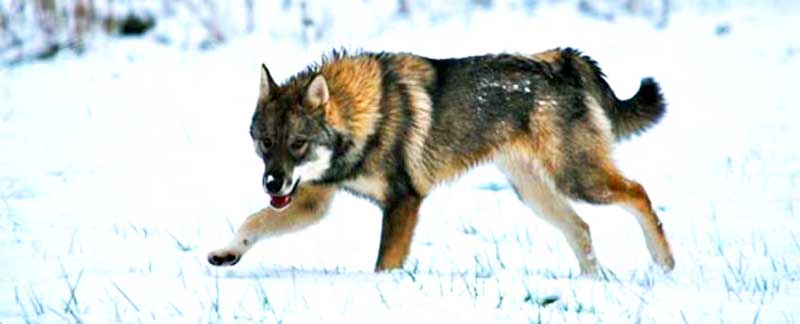
11.Moscow Watchdog
Moscow Watchdog (Russian: московская сторожевая, tr. moskovskaya storozhevaya) is a breed of dog that was bred in the Soviet Union. It descends from crosses between the St. Bernard and Caucasian Shepherd breed. It contains the physical size, attractiveness and intelligence of a St. Bernard and the awareness and assertive traits of a Caucasian Ovtcharka.
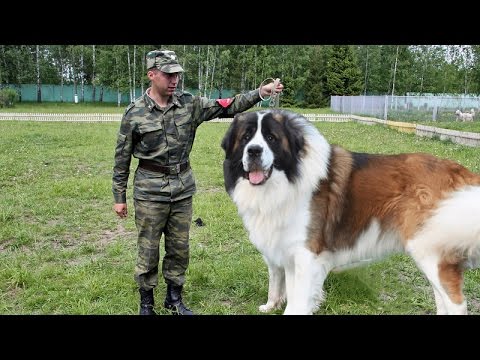
The breed is very large and weight is between 45 and 68 kg (100 and 150 lbs) with a life expectancy of 9-11 years. They are known to be a large powerful breed with a gentle temperament, therefore if it is raised properly with training with discipline, the Moscow Watchdog could fit into any environment and be the perfect protective family pet. Unlike its modern St. Bernard counterparts, the breed needs lots of vigorous exercises. They do not drool like many of the other molossers. Until recently, Moscow Watchdogs were very hard to find outside of Russia and former Soviet states, however, are now becoming more popular in Europe and have recently reached the United States. The first litter of Moscow Watchdogs was born in the US on June 6, 2015. There are currently 27 Moscow Watchdogs living in the United States.
Appearance
Related to mountain dogs, the Moscow Watchdog, one of the larger dog breeds, stands between 64 and 69 cm (25 and 27 inches) tall and weighs 45 to 68 kg (100 to 150 pounds). They are a muscular dog that has a bulky head and powerful legs. Their coat is thick in a moderate length with the colour white and red. Their puffy tail is long enough that it could touch the floor. They are an average shedder and with a well-arched chest, they generally give an impression of firmness and confidence.
12.Moscow Water Dog
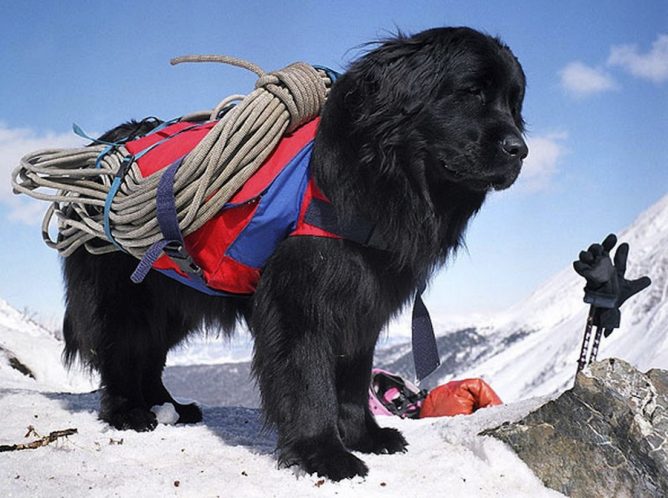
The Moscow Water Dog, also known as the Moscow Diver, Moscow Retriever or Moskovsky Vodolaz, is a little-known dog breed derived from the Newfoundland, Caucasian Shepherd Dog and East European Shepherd. It is now extinct but was used in the development of the Black Russian Terrier. The Moscow Water Dog was produced only by the Red Star Kennels, the state-operated organization chartered to provide working dogs for the armed services of the Soviet Union.
After World War II, there were very few working dogs in the Soviet Union as many had been killed during the war. Some were imported but there were not enough to establish a dedicated breeding programme for a specific breed. The Central Military School of Working Dogs (the Red Star Kennels), under the command of Colonel G. P. Medvedev, began working on developing a number of their own specialised breeds by crossing the available stock. A few breeds were established including the Moscow Newfoundland, a cross of German Shepherd Dog and Newfoundland; the Moscow Great Dane, using German Shepherd and Great Dane; the Brudasty Hound, which was an Airedale Terrier and Russian Hound mix; the Moscow Watchdog, a combination of St. Bernard and Caucasian Shepherd Dog; and the Moscow Water-Dog. The most successful breed to come out of the programme was the Black Russian Terrier, which gained international recognition in 1984; it derived from a combination of 14 different breeds including the Moscow Water Dog in the later stages of its development.
Moscow Water Dogs were bred in Krasnaya Zvezda, Belarus, by interbreeding Newfoundland males with East European Shepherd and Caucasian Shepherd Dog females, and by mating the offspring with each other. They were developed as a water rescue/lifesaving dog, but according to O. Krasnovskaya, “That was not a good idea as [they] were not willing to save drowning people, but most were looking to bite them, so this breed was never developed”.
13.Russian Spaniel
The Russian Spaniel is a type of spaniel first standardised in 1951 in the Soviet Union after World War II by cross-breeding English Cocker Spaniels, English Springer Spaniels and other spaniel breeds. Physically it is similar to a Cocker Spaniel but has a shorter, tighter coat and a longer body. Developed and used as hunting dogs, this breed does not suffer from any major health complaints other than those normally associated with spaniels. Popular in its native Russia, the breed was only introduced overseas in the 1990s and is not yet recognised by any major kennel clubs.
History
The Russian Spaniel is the youngest of the Russian gundogs. It originated mostly from English Cocker Spaniels and English Springer Spaniels. Breeds known as Russian Spaniels have been mentioned as early as 1891 in New Zealand.
The first recorded spaniel in Russia was a black Cocker Spaniel owned by hunting enthusiast Grand Duke Nicholas Nikolaevich towards the end of the 19th century. Because of its noble connections, spaniels of various breeds were imported to St. Petersburg and Moscow. Some were used for hunting, but the smaller spaniels were not of much use in Russian bird hunting due to the weather and terrain conditions. It was at the beginning of the 20th century that selective breeding began for longer-legged spaniels; specifically importing Springer Spaniels to create a rather mixed Russian Spaniel.
By the late 1930s, there were a variety of spaniels in Moscow, Leningrad and Sverdlovsk that did not fit any specific spaniel breed standard, but were not yet standardised into the modern Russian Spaniel. Purposeful breeding after World War II led to the original Russian Spaniel standard in 1951. Further revised standards were issued in 1966 and 2000.
The popularity of the breed in Russia increased after the early 1990s, with Moscow dog shows since that time annually including between 120 and 131 Russian Spaniels, which qualifies the breed as one of the most popular, along with the Irish Setter. In 2002, the Russian Spaniel Club was set up in the United States to increase the knowledge of the breed outside Russia and to enable owners to register their dogs.
14.Russian tracker
The Russian Tracker or Russian Retriever is an extinct breed of domestic dog. It is uncertain when precisely the breed ceased to exist; it could still be found in the late 1800s. The Tracker was of Asiatic Russian origin. It was used for hundreds of years to protect and herd the flocks of the Indo-Aryan people in the wind-beaten, snow-swept Caucasus Mountains.
The Tracker was a large dog, sometimes standing as high as 30 inches (76 cm) at the shoulder and weighing 100 pounds (45 kg) or more. Despite its seemingly cumbersome proportions, it was fast and flexible enough to chase off wolves and other such predators that threatened its sheep. It wore a thick, taffy coloured double-coat that protected it from both the harsh weather and the savage wildlife. Aside from its physical prowess, this mountain dog also had exceptional intellect. It was so wise and capable (legend says) that it could keep itself and its flock alive and well for months on end with no human help.
The breed is related to on some level and maybe synonymous with, the Yellow Russian Retriever, which measured 28 inches (71 cm) and 90 pounds (41 kg). That breed was reputed to be used for tracking wounded deer. The Tracker’s closest surviving descendant is the Golden Retriever; however, the Flat-coated Retriever and a few of the Setters are also believed to carry Tracker blood.
15.Russkiy Toy
The Russian Toy (also known as the Russian Toy Terrier, and in Russia as the Russkiy Toy, Toychik, Russian: Русский той, Тойчик) is a very small breed of dog originally bred in Russia from the English Toy Terrier. There are two types of coats in the breed: smooth coat and long coat. The smooth-coated variety was previously known as the Russian Toy Terrier and long-coated as the Moscow Long Haired Toy Terrier. Both were brought together under the same Russian Toy Terrier name in 1988 and the “Terrier” was dropped from the name when the breed was added in 2006 to the official list of breeds registered with the Fédération Cynologique Internationale and has been registered in the Foundation Stock Service of the American Kennel Club since 2008, allowed to compete in AKC companion events since 2010. The first official breed standard of the two varieties was written in 1966 in Russia
The breed was nearly wiped out twice; first in the 1920s with the rise of Communism due to the toy dog’s traditional link to the aristocracy and again in the 1990s with the influx of foreign breeds following the fall of the Iron Curtain. The smooth coat type is the older of the two, with the long coat type first appearing in 1958.
Until the 1990s, the breed was almost unknown outside of Russia, and so relatively few details on associated health issues are known. The Russian Toy was originally bred as a rat fighter and as a watchdog, and can still exhibit the vocalization expected from the latter. It is a friendly dog and can become very attached to the family unit. Due to its size and similarities to the chihuahua, the two are often compared.
History
The first evidence of English-style terriers in Russia can be seen in the Museum of Zoology in Saint Petersburg. On display is an English style terrier dated 1716–1726 with a sign that reads “This dog is a short hair terrier named Lizetta. It personally belonged to the Russian Emperor Peter the Great.” Indeed, the breed was developed as a companion dog for Russian nobility. According to some accounts, records indicate that eight smooth-coated Russian Toys competed in a dog show in Saint Petersburg as far back as 1874. The more generally accepted the first reference to the breed appears in May 1907 when 11 Russian Toys were shown at an exhibition in Saint Petersburg. In 1923, two dogs appeared at a Moscow dog show and in 1924, three more were awarded medals at a show in Odessa. But as a result of the October Revolution, the Russian Toy diminished in popularity and in numbers as these types of dogs were closely linked to the aristocracy and therefore frowned upon. In 1947, only one dog was shown in Saint Petersburg. When breeding began to revitalize the stock of Russian Toys in Russia, only a few of the dogs left had pedigrees or were purebred.
The lack of numbers and political isolation of the country at the time caused the creation of a new breed quite distinct from the former English style toy dog as breeders sought to stabilise the remaining toy-sized terriers into a standard breed. The resulting contemporary Russian Toy has most of the features of the classic toy terrier, with the addition of some new characteristics. The head is high but not wide, the cheeks are flat and the eyes are round. By 1960, 76 dogs were entered into an exhibition and the first standard for the two Russian Toy varieties was written in 1966 and authorized by the Ministry of Agriculture.
In 1988, the Russian Kynological Federation published a new breed standard, combining the short-coated Russian Toy Terrier and the long-coated Moscow Toy Terrier under “Russian Toy Terrier.” However, after the fall of the Iron Curtain in 1989, the popularity of imported exotic breeds nearly drove the Russian Toy into extinction. A resurgence occurred thanks to a new energetic generation of dog breeders, but the breed remained virtually unknown outside of Russia until the 1990s. Several kennels have now been established outside Russia, the most successful ones located in Finland, Estonia, Belarus, Ukraine and Czech Republic. Interest in the breed is on the rise in the USA and Japan.
The Russian Toy was provisionally recognised by the Federation Cynologique Internationale in 2006 and gained definitive recognition in 2017.
The United Kennel Club and The Foundation Stock Service of the American Kennel Club both accepted the breed in 2008
Russian Toys are also recognized by the American Rare Breed Association and International All Breed Canine Association. Read More…
16.Russo-European Laika
Russo-European Laika (Russko-Evropeĭskaya Láĭka) is the name of a breed of hunting dog that originated in the forested region of northern Europe and Russia, one of several breeds developed from landrace Laika dogs of Spitz type. The Russo-European Laika itself dates to a breeding program begun in 1944 by E. I. Shereshevsky of the All-Union Research Institute for the Hunting Industry, in Kalinin (now Tver) Province.
17.Sakhalin Husky
The Sakhalin Husky, also known as the Karafuto Ken (樺太犬), is a breed of dog formerly used as a sledge dog, but now nearly extinct.
As of 2011, there were only two surviving purebred members of the breed in Japan. The sole remaining breeder, Sergey Lyubykh, located in the Nivkh village of Nekrasovka, died in 2012, but before his death stated that there were no longer enough living specimens of the breed to allow for the genetic diversity necessary for continued breeding
History
Karafuto Ken breaks down as Karafuto, the Japanese name for Sakhalin and Ken, a Japanese word for the dog; hence, this provides the breed’s geographical origin. This breed is rarely used now; therefore, few breeders remain in Japan.
Explorers who went to Franz Josef Land, conquerors of northern Alaska, and South Pole explorers (including Robert Falcon Scott) used these dogs. They were utilized by the Red Army during World War II as pack animals, but that affair was short-lived after research proved that they were prodigious eaters of salmon, and not worth keeping.
Offshoots of the Sakhalin Husky are theorized to be the progenitors of longer-coated Akitas.
18.Samoyed dog
The Samoyed (/ˈsæməjɛd/ SAM-ə-yed or /səˈmɔɪ.ɛd/ sə-MOY-ed; Russian: Самое́дская соба́ка or Самое́д) (also known as the Bjelkier) is a breed of large herding dog that descended from the Nenets herding laika, a spitz-type dog, with a thick, white, double-layer coat.
It takes its name from the Samoyedic peoples of Siberia. These nomadic reindeer herders bred the fluffy white dogs to help with the herding.
History
The Samoyed has been identified as a basal breed that predates the emergence of the modern breeds in the 19th Century. Its belongs to the spitz or northern dog group, specifically the laikas, a Eurasian dog type used for a variety of purposes, namely hunting, herding, guarding, and sledging. The Samoyed is descended from the Nenets herding laika, a dog that comes in not only white but also a wider variety of colours. Like many breeds, the Samoyed was bred from a small number of founders (in this case, from Siberia).
Samoyeds were originally used for hunting, herding reindeer, and hauling sledges for the Samoyede people in Siberia. Fridtjof Nansen believed that the use of sledge dogs was the only effective way to explore the north and used Samoyeds on his polar expeditions. Read More…
19.Siberian Husky
The Siberian Husky (Russian: Сибирский хаски, tr. Sibirskiy khaski) is a medium-size working dog breed. The breed belongs to the Spitz genetic family. It is recognizable by its thickly furred double coat, erect triangular ears, and distinctive markings, and is smaller than a very similar-looking dog, the Alaskan Malamute.
Siberian Huskies originated in Northeast Asia where they are bred by the Chukchi people for sledge-pulling, guarding and companionship. It is an active, energetic, resilient breed, whose ancestors lived in the extremely cold and harsh environment of the Siberian Arctic. William Goosak, a Russian fur trader, introduced them to Nome, Alaska during the Nome Gold Rush, initially as sledge dogs. Read More…
History
The original sledge dogs bred and kept by the Chukchi were thought to have gone extinct, but Benedict Allen, writing for Geographical magazine in 2006 after visiting the region, reported their survival. His description of the breeding practised by the Chukchi mentions selection for obedience, endurance, amiable disposition, and sizing that enabled families to support them without undue difficulty.
With the help of Siberian Huskies, entire tribes of people were able not only to survive but to push forth into terra incognita.
The Siberian Husky, Samoyed, and Alaskan Malamute are all breeds directly descended from the original sledge dog. It is thought that the term “husky” is a corruption of the nickname “Esky” once applied to the Eskimo and subsequently to their dogs.
Dogs from the Anadyr River and surrounding regions were imported into Alaska from 1908 (and for the next two decades) during the gold rush for use as sledge dogs, especially in the “All-Alaska Sweepstakes,” a 408-mile (657-km) distance dog sledge race from Nome, to Candle, and back. Smaller, faster and more enduring than the 100- to 120-pound (45- to 54-kg) freighting dogs then in general use, they immediately dominated the Nome Sweepstakes. Leonhard Seppala, the foremost breeder of Siberian Huskies of the time, participated in competitions from 1909 to the mid-1920s.
Gunnar Kaasen and Balto
On February 3, 1925, Gunnar Kaasen was first in the 1925 serum run to Nome to deliver diphtheria serum from Nenana, over 600 miles to Nome. This was a group effort by several sledge-dog teams and mushers, with the longest (91 miles or 146 km) and the most dangerous segment of the run covered by Leonhard Seppala. The event is also loosely depicted in the 1995 animated film Balto, as the name of Gunnar Kaasen’s lead dog in his sledge team was Balto, although unlike the real dog, Balto the character was portrayed as half wolf in the film. In honour of this lead dog, a bronze statue was erected at Central Park in New York City. The plaque upon it is inscribed, Dedicated to the indomitable spirit of the sledge dogs that relayed antitoxin six hundred miles over rough ice, across treacherous waters, through Arctic blizzards from Nenana to the relief of stricken Nome in the winter of 1925. Endurance · Fidelity · Intelligence
In 1930, the exportation of the dogs from Siberia was halted. The same year saw recognition of the Siberian Husky by the American Kennel Club. Nine years later, the breed was first registered in Canada. The United Kennel Club recognized the breed in 1938 as the “Arctic Husky,” changing the name to Siberian Husky in 1991. Seppala owned a kennel in Nenana before moving to New England, where he became partners with Elizabeth Ricker. The two co-owned the Poland Springs kennel and began to race and exhibit their dogs all over the Northeast.
As the breed was beginning to come to prominence, in 1933 Navy Rear Admiral Richard E. Byrd brought about 50 Siberian Huskies with him on an expedition in which he hoped to journey around the 16,000-mile coast of Antarctica. Many of the dogs were trained at Chinook Kennels in New Hampshire. Called Operation Highjump, the historic trek proved the worth of the Siberian Husky due to its compact size and greater speeds. Siberian Huskies also served in the United States Army’s Arctic Search and Rescue Unit of the Air Transport Command during World War II. Their popularity was sustained into the 21st century. They were ranked 16th among American Kennel Club registrants in 2012, rising to 14th place in 2013.
Siberian huskies gained in popularity with the story of the “Great Race of Mercy,” the 1925 serum run to Nome, featuring Balto and Togo. Although Balto is considered the more famous, being the dog that delivered the serum to Nome after running the final 53-mile leg, it was Togo who made the longest run of the relay, guiding his musher Leonhard Seppala on a 91-mile journey that included crossing the deadly Norton Sound to Golovin.
In 1960, the US Army undertook a project to construct an under the ice facility for defence and space research, Camp Century, part of Project Iceworm involved a 150+ crew who also brought with them an unofficial mascot, a Siberian Husky named Mukluk.
20.South Russian Ovcharka
The South Russian Ovcharka, also known as a Ukrainian Shepherd Dog, or South Russian Sheepdog, is a sheepdog from the Ukrainian steppes between the Black Sea and the Sea of Azov.

Russian Sheepdog circa 1915
This mountain dog is an undemanding dog, which can adapt to most weather conditions.
Description
Males should stand no less than 25 inches (64 cm) tall, it has a long head, with dangling, small, triangular ears. Its coat consists of long, thick coarse hair, usually white (although sometimes white with yellow, or with shades of grey), that is bushy and slightly wavy. The dog is banned in Denmark.
21.Sulimov dog
The Sulimov dog (Russian: Собакa Сулимова Sobaka Sulimova), also known as the Shalaika (Russian: Шалайка), is a Russian jackal-dog hybrid originating from an initial hybrid between two Lapponian Herders and two Turkmen golden jackals. The breed was developed by Klim Sulimov for Aeroflot airline security. He is described as a Senior Research Assistant at the D.S. Likhachev Scientific Research Institute for Cultural Heritage and Environmental Protection. The primary use of this breed has been to aid airport security as sniffer dogs. Quoting Sulimov, “My dogs combine the qualities of Arctic reindeer herding dogs, which can work in temperatures as low as -70°C, and jackals which enjoy the heat up to +40°C. They’re perfect for our country.”
During the breeding process, male jackal pups had to be fostered on a Lapponian Herder bitch to imprint the jackals on dogs. Female jackals accepted male dogs more easily. The half-bred jackal-dogs were hard to train and were bred back to Huskies to produce quarter-bred hybrids (quadroons). These hybrids were small, agile, and trainable and had excellent noses. They were then called Sulimov dogs after their creator and may one day be registered as a working breed of dog. Twenty-five Sulimov dogs are used by Aeroflot at Sheremetyevo Airport in Moscow, for functions which include bomb-sniffing. Their breeding program dates back to 1975 but was not applied to bomb detection until 2002.
The jackal-dog hybrids were bred together for seven generations to establish the breed. To improve trainability, other dogs were bred into the line: a reindeer herding hound, a fox terrier, and a Spitz. The result was an easily trainable dog with a superior sense of smell. Only about 40 of these dogs are in existence and they are all the property of Aeroflot. They are trained from puppyhood to recognize 12 components of explosives. Unlike more common sniffing dogs, they take the initiative in searching.
22.West Siberian Laika
The West Siberian Laika or WSL, is a breed of hunting dog and a breed of spitz type. Russian publications indicate that the term West Siberian Laika loosely applied to hunt dogs originating with the Mansi and Khanty people in the Ural and West Siberia, but there were no standards or registrations of WSL as such until 1930. Then WWll disrupted it for a while, but systematic breeding with registrations resumed after the war ended, in 1946. This was the time the breed began taking modern shape. Before that hunters only knew of Mansi Laika and Khanty Laika. In early 1960 many hunters in the Ural still preferred the term Mansi Laika, when speaking of West Siberian Laika. In the Russian language, the term Laika originated from the word layat that means to bark. The word Laika simply means barker. Any hunting Laika is a bark pointer (pointing at the animal of interest by barking and staying with the animal). It is a versatile dog depending on use and environment, but in certain parts of the country, they have become more specialized.
Origins
Laikas, occurring on Russian territory, belong to northern primitive breeds retaining traits of their wild ancestor, the wolf, in the appearance and behaviour. They are dogs with pointed muzzle, slightly rangy or nearly square body and often grey or grey mixed with red like in the wolf coat colour predominate. They are small to medium size pariah-type dogs that originally accompanied humans since prehistory worldwide until they became replaced with lop-eared, specialized for a certain style of hunting, cultured breeds. In large sparser populated parts of Russia, this process came at a later time and aboriginal Laika types still remain with hunters in remote northern and northeastern provinces of the country.
History
Deforestation of land for agriculture and industrialization in later 19th-early 20th Centuries accelerated replacement of Laikas with other popular at the time dogs. Russian experts of the late 19th century distinguished dozens of varieties of aboriginal Laikas, each associated with a particular ethnic group of indigenous people of northeastern Europe and Siberia, but none of them had been considered as purebred and pedigreed. Russians tried to save some hunting Laikas from extinction by bringing them from different provincial parts of Russia in cities of the European part of the country and breeding them pure. Starting from thirtieth and especially after WW II, they established four breeds as purebreds: the Karelo-Finnish Laika, the Russ-European Laika, the West Siberian Laika and the East Siberian Laika. They all are bark-pointing dogs and their hunting behaviour is generally similar. All of them are descendants of aboriginal types of Laikas selectively sampled from large territories and lumped into the four breeds for breeding in kennels. Among all of them, the West Siberian Laika became most popular and by the present time, it is most numerous Laika far beyond its original range in Russia.
23.Yakutian Laika
The Yakutian Laika (Russian: Якутская лайка) is a working dog breed that originated in the Arctic seashore of the Sakha (Yakutia) Republic. The major habitat is estuaries of Kolyma, Indigirka, Yana and Lena. In terms of functionality, Yakutian Laikas might serve as a reindeer herder’s dog (olenegonka), hunter’s dog, and a sledge dog. In September 2019, the FCI officially accepted the breed. Read More…
History
Yakutian Laikas were developed in ancient times by native Yakuts involved with hunting mammals and birds; the dogs were indispensable assistants. They proved to be a valuable asset and became companions to the Yakuts. In the Sakha language, this breed is known as “Sakha yta” meaning “Yakut dog”.
Description
This is a versatile dog with an excellent sense of smell, hearing and vision, strong hunting drive, endurance; they are aggressive to predators and soft and gentle to humans. They are multi-purpose, have got an excellent sense of smell, absolute pitch and good eyesight. Yakutian Laikas are not demanding to conditions of life and easily endure the hostile climate of northern Siberia. In harsh Siberian conditions, they reveal their stamina; they tend to work in small groups and can work through the whole day, from dawn to sunset. The popularity of dog sledging appeared with the arrival of Russian traders to the Arctic.
With the increased demand for white polar foxes in the 17th century, the Arctic exploration received its spike. Furs and mammoth tusks trade became local nations’ main income. Origin and subsequent formation of the breed are still not quite known, but because of the hard to access country and extreme natural conditions, Yakutian Laikas have lived as primitive aboriginal breeds; they were rarely confined and mated freely. Naturally, local type dogs could be preserved only under conditions of complete isolation from dogs of other breeds. First scientific descriptions of dogs of Yakutia were published in the late 18th century when first geographic studies of the north were conducted. Prince Shirinsky-Shikhmatov wrote in his monograph about Laikas: “Researchers of the north, of course, could not overlook northern dog; they could not disagree with the hard fact that presence of this dog makes the life of northern people possible.
It is even more strange that so little attention was paid to the description of dogs of the north; their ancestral aboriginal type and numerous varieties remain obscure. There are as many types of Laikas as ethnic minorities of the north; varieties of Laikas differ clearly from each other, each has its own peculiarities and their division is indisputable”. This monograph was written in 1898. Russian Geographic Society gave the task to Mr. Maak to investigate Vilyuisk District. “Review of Vilyuiks District of Yakutian Province” was published in 1877. Maak wrote: “I saw a dog of very typical appearance and very common in Siberia, which was fox-like”. In 1896, V. L. Seroshevsky published a book “Yakuts”, edited by N. I. Veselovsky. Describing dogs of Yakuts, Seroshevsky divides them into two groups, 1) guarding and hunting dogs and 2) maritime sledge dogs. He wrote: “even most poor Yakut having no other animals, has at least one dog”. Yokhelson (Johelson?), 1898, in his publication “Hunting Industry in Kolyma Territory of Yakutian Province” and described the Tungus Lajka used for sledging and hunting dogs.
He wrote: “There are two breeds of dogs, one is so-called Tungus Laika, a pointed-eared dog of nomadic reindeer herders and polar sledge dog”. All researchers described dogs of Yakutia as one breed of “polar sledge dogs”. Yokhelson wrote: “Sled dog is a burden animal not only of nomads living in not a forested country but also of settled near the river Russians and Russified minorities and the dog of the majority of cattle keeping Yakuts. Except for the southwestern part of the territory, one can find 5-6 dogs in every yurta, which are used for hauling firewood and other works needed by the household. The polar dog is not big, 50-60 cm at the shoulder… In the appearance, with his prick ears, oblique set eyes, thick coat and broad massive head, pointed muzzle, low carried tail (when the dog is tired, eats or in a bad mood), the dog is very similar to the wolf. Among them, there are shaggy dogs, and somewhat blunt muzzle not different from our Spitzes … Generally, the type of Kolyma sledge dog is diverse and, perhaps, it is a mix between Kamchatka and Eskimo sledge dogs with another imported breed.”
It stands to a reason that other dogs relocated here together with new immigrants. Both Seroshevsky and Yokhelson described the Yakutian Sled Dog similarly: “Legs relatively thick and short, chest, which is used to pull sledges, perfectly developed; the neck is thick and short. The face is unusually intelligent and with the melancholic or grim expression”. In principle, it remains so today and the dogs little changed with the spreading civilization in the Yakutian north. Read More…
